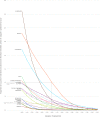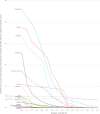Elevation as a proxy for mosquito-borne Zika virus transmission in the Americas
- PMID: 28542540
- PMCID: PMC5443570
- DOI: 10.1371/journal.pone.0178211
Elevation as a proxy for mosquito-borne Zika virus transmission in the Americas
Abstract
Introduction: When Zika virus (ZIKV) first began its spread from Brazil to other parts of the Americas, national-level travel notices were issued, carrying with them significant economic consequences to affected countries. Although regions of some affected countries were likely unsuitable for mosquito-borne transmission of ZIKV, the absence of high quality, timely surveillance data made it difficult to confidently demarcate infection risk at a sub-national level. In the absence of reliable data on ZIKV activity, a pragmatic approach was needed to identify subnational geographic areas where the risk of ZIKV infection via mosquitoes was expected to be negligible. To address this urgent need, we evaluated elevation as a proxy for mosquito-borne ZIKV transmission.
Methods: For sixteen countries with local ZIKV transmission in the Americas, we analyzed (i) modelled occurrence of the primary vector for ZIKV, Aedes aegypti, (ii) human population counts, and (iii) reported historical dengue cases, specifically across 100-meter elevation levels between 1,500m and 2,500m. Specifically, we quantified land area, population size, and the number of observed dengue cases above each elevation level to identify a threshold where the predicted risks of encountering Ae. aegypti become negligible.
Results: Above 1,600m, less than 1% of each country's total land area was predicted to have Ae. aegypti occurrence. Above 1,900m, less than 1% of each country's resident population lived in areas where Ae. aegypti was predicted to occur. Across all 16 countries, 1.1% of historical dengue cases were reported above 2,000m.
Discussion: These results suggest low potential for mosquito-borne ZIKV transmission above 2,000m in the Americas. Although elevation is a crude predictor of environmental suitability for ZIKV transmission, its constancy made it a pragmatic input for policy decision-making during this public health emergency.
Conflict of interest statement
Figures




References
-
- World Health Organization. International Health Regulations. WHO; 2005; 82.
-
- Weiss RA, McMichael AJ. Social and environmental risk factors in the emergence of infectious diseases. Nat Med. 2004;10: S70–S76. doi: 10.1038/nm1150 - DOI - PMC - PubMed
-
- Woolhouse M. How to make predictions about future infectious disease risks. Philos Trans R Soc Lond B Biol Sci. 2011;366: 2045–54. doi: 10.1098/rstb.2010.0387 - DOI - PMC - PubMed
-
- Kraemer MUG, Sinka ME, Duda KA, Mylne AQN, Shearer FM, Barker CM, et al. The global distribution of the arbovirus vectors Aedes aegypti and Ae. albopictus. Elife. 2015;4: e08347 doi: 10.7554/eLife.08347 - DOI - PMC - PubMed
-
- Kraemer MUG, Hay SI, Pigott DM, Smith DL, Wint GRW, Golding N. Progress and challenges in infectious disease cartography. Trends Parasitol. 2016;32: 19–29. doi: 10.1016/j.pt.2015.09.006 - DOI - PubMed
MeSH terms
Grants and funding
LinkOut - more resources
Full Text Sources
Other Literature Sources
Medical

